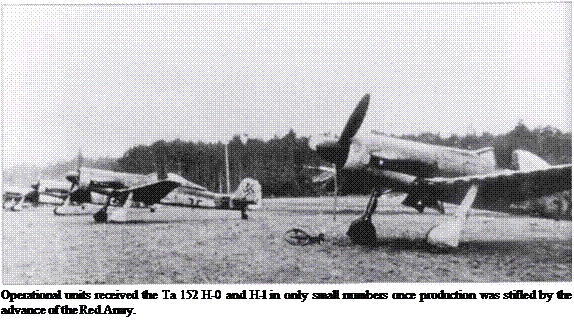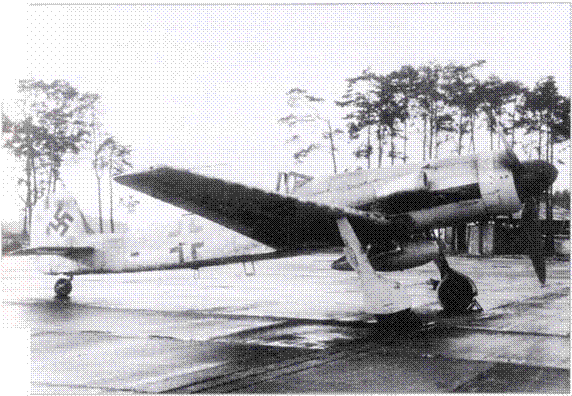The Та 152 High-Performance Fighter
 |
In comparison to Fw 190 D production, the Та 152 had a shadowy existence. After 3 aircraft in October, 12 in November and 19 in December 1944,23 came off the lines in January and 10 in February. At year’s end 1944 problems were encountered with the Та 152 H-0 starter motors at Cottbus Works. Three

normal Та 152 prototypes were airworthy in January with the DB 603 E engine, the more powerful DB 603 motors not being available, while the total loss of production at Posen, where Та 152 fuselages and wings were made, could not be rectified. The Erfurt firm Mimetall delivered its first two Та 152s in February. Other firms from whom the first deliveries were expected in March were Siebel of Halle and ATG Merseburg. The last machines were assembled from spare parts. Most of the 21 Та 152 H-Os were received at KdE; Luftflottenkommando Reich took seven more and another went directly to III./JG 301. Luftflotte Reich also took possession of the first Та 152 H-2 in the spring of 1945. Losses at JG 301 ensured that the number of operational machines never exceeded twelve and at the beginning of March 1945 only five Та 152 H-Os and H-2s remained.
III./JG 301 flew the operational trials instead of EK 152. As the front line edged ever closer to Berlin, EK 152’s airfield, Alteno (Luckau), was soon home to various fighter and Jabo Gruppen which was naturally unhelpful for Та 152 testing. When the major Soviet offensive began, III. Gruppe was ordered
unwittingly to an airfield behind Russian lines. Only a few of the Та 152s managed to get clear, the remainder being destroyed by explosion to prevent their falling into enemy hands. By 21 January 1945 fourteen new machines had been lost to enemy action or failures in flight. At the end of the month Oberfeldwebel Josef Keil scored the first success when his Та 152 shot down a B-17 bomber over Berlin. On 2 February, Leutnant Hagendorn of 9./JG 301, who took off with two wingmen to attack RAF Mosquitos, flew at over 12,500 metres (41,000 ft) altitude.
Once the Posen works fell into Soviet hands at the end of February 1945, the supply of new aircraft dried up. Allied attacks on hangars and parking areas together with combat losses against the Eighth Air Force accounted for other Та 152s. On 25 March 1945 only Stab/JG 301 had machines operational. That day part of III. Gruppe arrived unexpectedly at Hannover-Langenhagen which had just been attacked by Allied bombers. The runways and taxying areas were therefore full of bomb craters and a number of crash landings occurred. At the end of March 1945 a number of Fw 190 D-9s attacked enemy camps and vehicle columns with AB 250s and AB 500s. On 1 April 1945 pilots dropped numerous SD-1 anti-personnel bombs from an altitude of only 10 metres (30 ft) in a successhil attack against US supply lorries: next day several Fw 190 D-9s led by Hauptmann Posselmann made a successful attack on ground targets near Kassel. After these operations the aircraft returned to the east, landing at Hagenow, a small airfield on the road to Ludwigslust. On 10 April 1945 Oberfeldwebel Keil took off from Sachau airfield near Gardelegen. North-east of Brunswick he engaged an formation of at least 15 P-47 fighters and shot down at least one.
The same day Stab/JG 301 reported two Та 152 and 36 Fw 190s at I. and
II. Gruppen, 49 aircraft being operational in all. The staff flight had seven Та 152s, of which only three were operational and parked in the blast pens. On 24 April Feldwebel Walter Loos flying a Та 152 H-0 (Works No. 150003) shot down two Soviet Yak 9s over Berlin, and claimed another next day. On 30 April he shot down an La 9 and thus became the most successful Та 152 pilot in the Luftwaffe.
That day Stab/JG 301 at Welzow had only two aircraft, these being modern all-weather Та 152 C-1/R31 fighters. Both machines were operational and equipped with K-23 auto-pilots. To the extent that fuel supplies allowed, the Geschwader could call on more than 50 Fw 190 D-9s and Bf 109 G-14s at Alteno, Finsterwalde and Welzow. III./JG 301 at Luckau was already disbanded at this time. In the first days of May the remnants of JG 301 pulled back from Hagenow to Neustadt-Gleve from where the last missions were flown, although
III. Gruppe made for Leek in Schleswig-Holstein. An armistice was observed there as from 5 May 1945.










